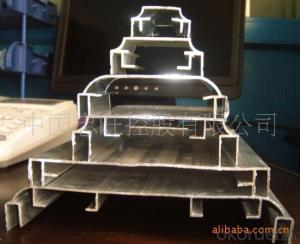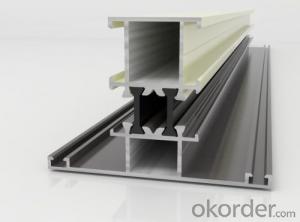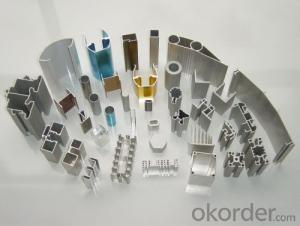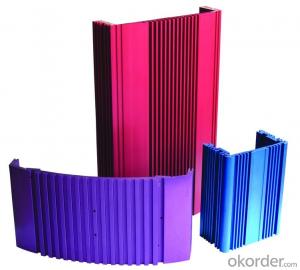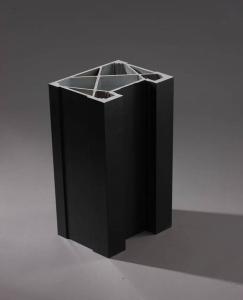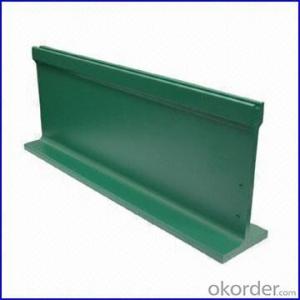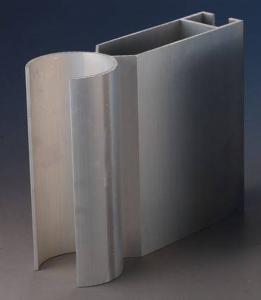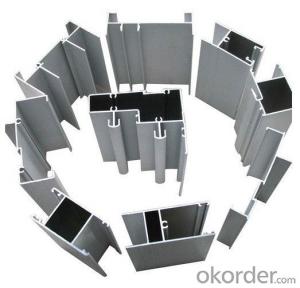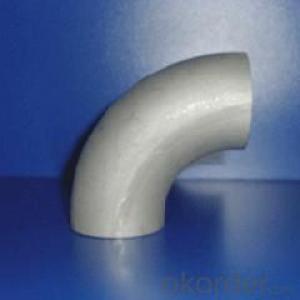LED Aluminum Extrusion Profiles Canada
OKorder Service Pledge
OKorder Financial Service
You Might Also Like
Weare the largest aluminum profile manufacture in
The detail descriptions of aluminum profile as bellowing:
Alloy Aluminum 6063,6061,6005,6082 or customer nominated | |
Temper | T3, T4, T5, T6 and other |
Surface | Anodize, electrophoresis, powder coating, PVDF coating, wood grain painting, etc. |
Colour | Any colour based on Standard Germany RAL Mark |
Length | Not more than 16 meters |
Good Package | Inner plastic film /outside carton/wooden pallets |
Payment Method | T/T, L/C, etc |
Delivery Time | Normally 2-4 weeks, Delivery time can be consulted. |
Press Machine | 500-12500 tons all together 93 press lines. |
Fabrication | 1. LED frame; 2. Drilling; 3. Bending; 4. Cutting; 5. etc. |
Certificate | ISO/TS 16949,DNV,IRIS,CCS,AFA,etc. |
Dies | 1. Using our dies, no fee; |
2. Using customer drawing, opening dies, usually about 5~50 tons then the dies cost can be refunded. | |
3. Die cost is negotiable base on the order quantity | |
Capability | Annual output 800,000 tons |
- Q: Are there any regulations or standards that aluminum profiles must meet?
- To ensure the quality and safety of aluminum profiles, they must adhere to various regulations and standards. The specific requirements vary depending on the application and industry. Here are some commonly followed regulations and standards: 1. ISO Standards: The International Organization for Standardization (ISO) has established several standards for aluminum profiles. These include ISO 9001 for quality management systems, ISO 14001 for environmental management systems, and ISO 9001 for occupational health and safety management systems. 2. ASTM International Standards: ASTM International provides standards for aluminum profiles used in construction, transportation, and other industries. These standards specify the chemical composition, mechanical properties, and dimensional tolerances that aluminum profiles must meet. 3. American National Standards Institute (ANSI) Standards: ANSI develops standards for aluminum profiles used in various applications. These standards address design, performance, and safety requirements. 4. European Standards (EN): In Europe, aluminum profiles must meet the criteria set by the European Committee for Standardization (CEN). These standards define the characteristics, dimensions, and tolerances of aluminum profiles used in construction, aerospace, automotive, and other industries. 5. National Regulations: Many countries have their own regulations governing the use of aluminum profiles. These regulations cover aspects such as fire safety, structural integrity, and environmental impact. Manufacturers, suppliers, and users of aluminum profiles must comply with these regulations and standards to ensure the quality, reliability, and safety of their products and applications. Adhering to these standards helps maintain consistency, interoperability, and customer confidence across various industries that use aluminum profiles.
- Q: How do aluminum profiles perform in seismic or earthquake-prone areas?
- Aluminum profiles have shown to perform well in seismic or earthquake-prone areas due to their inherent properties. Aluminum is a lightweight and flexible material, which allows it to absorb and dissipate seismic energy effectively. This helps in reducing the impact of earthquakes on structures and minimizing damage. Additionally, aluminum profiles are highly resistant to corrosion, which is beneficial in areas with high seismic activity as it ensures the longevity and structural integrity of buildings.
- Q: How do you ensure proper weatherproofing with aluminum profiles?
- To ensure proper weatherproofing with aluminum profiles, it is essential to consider three key aspects: proper installation, effective sealing, and regular maintenance. Firstly, the profiles should be installed correctly, ensuring tight joints and secure fastening to prevent water leakage. Secondly, applying high-quality sealants or gaskets at the joints and corners helps to create a watertight barrier. Lastly, regular inspection and maintenance, such as checking for any damage or wear and resealing as needed, will help maintain the weatherproofing effectiveness of aluminum profiles over time.
- Q: This question asks for an overview of the various types of aluminum profiles that are utilized in the construction of interior partitions and ceilings.
- <p>Aluminum profiles for interior partitions and ceilings come in various types, each serving specific purposes and functions. Common types include: 1. U-Channel profiles, used for creating the framework of ceilings and partitions. 2. T-profiles, often used as a cover for the joints between panels. 3. H-profiles, which are used as main beams in ceiling systems. 4. Angle profiles, used for corner connections and support. 5. Flat bar profiles, used for decorative or functional purposes in ceilings and partitions. 6. Box profiles, which can be used for both structural and aesthetic applications. 7. Special profiles, designed for specific applications such as lighting fixtures or air conditioning ducts. These profiles are chosen based on the design requirements, load-bearing needs, and aesthetic preferences for the project.</p>
- Q: Can aluminum profiles be used in the construction of retail displays?
- Yes, retail displays can utilize aluminum profiles in their construction. Aluminum is a versatile and lightweight material that finds common application in various industries, such as construction and retail. It provides several benefits for retail displays, including durability, resistance to corrosion, and ease of customization. Aluminum profiles can be effortlessly shaped and fabricated to create diverse types of retail displays like shelving units, display stands, signage frames, and product showcases. These profiles can be extruded into different shapes and sizes, enabling flexibility in design and functionality. Moreover, aluminum profiles can undergo various surface treatments, such as anodizing or powder coating, to enhance their appearance and offer a protective layer against scratches and wear. This ensures that retail displays can maintain their aesthetic appeal and withstand the demands of a retail setting. Furthermore, aluminum is an eco-friendly material due to its high recyclability, making it an environmentally conscious choice for retail displays. It can be easily recycled without losing its properties, thus reducing the environmental impact of the construction and retail industries. To summarize, aluminum profiles are a practical and appropriate option for constructing retail displays. They provide durability, versatility, and customization possibilities while being lightweight and environmentally friendly.
- Q: Are aluminum profiles suitable for use in the mining industry?
- Yes, aluminum profiles are suitable for use in the mining industry. Aluminum is lightweight, corrosion-resistant, and durable, making it ideal for various applications in mining equipment and infrastructure. It offers strength and stability while being easy to transport and install. Additionally, aluminum profiles can withstand harsh environmental conditions and are resistant to chemicals commonly found in mining operations.
- Q: Are there any special considerations for installing aluminum profiles?
- Yes, there are a few special considerations for installing aluminum profiles. Firstly, it is important to ensure that the installation surface is clean and free from any debris or contaminants that could affect the adhesion or stability of the profiles. Secondly, proper measurement and alignment are crucial for a precise and secure installation. Additionally, it is advisable to use appropriate tools and techniques for cutting and shaping the profiles to avoid any damage or distortion. Finally, if the installation involves outdoor or high-moisture areas, it is recommended to use aluminum profiles that are specifically designed for such conditions to ensure longevity and durability.
- Q: What are the load-bearing capacities of different aluminum profile shapes?
- The load-bearing capacities of different aluminum profile shapes vary depending on various factors such as the specific alloy of aluminum used, the size and dimensions of the profile, and the specific application or use case. Aluminum profiles, also known as extrusions, come in a wide range of shapes including I-beams, T-beams, square tubes, rectangular tubes, angles, and channels. Each profile shape has its own unique load-bearing capacity due to its structural design and cross-sectional properties. For example, I-beams are known for their high load-bearing capacity due to their shape, which allows for efficient weight distribution along the flanges. They are commonly used in structural applications where heavy loads need to be supported. T-beams, on the other hand, have a load-bearing capacity similar to I-beams but with a different cross-sectional shape. They are often used in applications where a flat surface is required on one side, such as in construction or automotive industries. Square and rectangular tubes are versatile profiles that are often used in building structures, frames, and support systems. Their load-bearing capacity depends on the wall thickness and size of the tube. Angles and channels, which have a L-shaped and U-shaped cross-section respectively, are commonly used in construction and manufacturing industries. Their load-bearing capacity depends on the size and dimensions of the profile. It is important to note that the load-bearing capacities of aluminum profiles are typically provided by the manufacturer and should be consulted for specific applications. Additionally, engineering calculations and considerations such as deflection, bending moments, and safety factors should be taken into account when determining the appropriate aluminum profile shape and size for a given load-bearing requirement.
- Q: What are the specific requirements or considerations when using aluminum profiles in the construction or design of swimming pools and spas?
- <p>Yes, there are special requirements for using aluminum profiles in swimming pools and spas. These include corrosion resistance to withstand chlorinated water, which is common in pools and spas. Profiles must be made of marine-grade aluminum to prevent rust and ensure longevity. They should also be able to withstand high humidity and temperature fluctuations. Additionally, profiles need to be non-slip and easy to clean to maintain safety and hygiene. The design should also consider structural integrity to support the weight of the pool or spa structure and any associated equipment.</p>
- Q: Are aluminum profiles suitable for modular office systems?
- Yes, aluminum profiles are suitable for modular office systems. Aluminum profiles are lightweight, durable, and have excellent structural integrity, making them ideal for constructing modular office systems. They are easy to assemble, disassemble, and reconfigure, allowing for flexibility and adaptability in office layouts. Additionally, aluminum profiles can be customized to meet specific design requirements, offering a sleek and modern aesthetic to modular office systems.
Send your message to us
LED Aluminum Extrusion Profiles Canada
OKorder Service Pledge
OKorder Financial Service
Similar products
Hot products
Hot Searches
Related keywords
